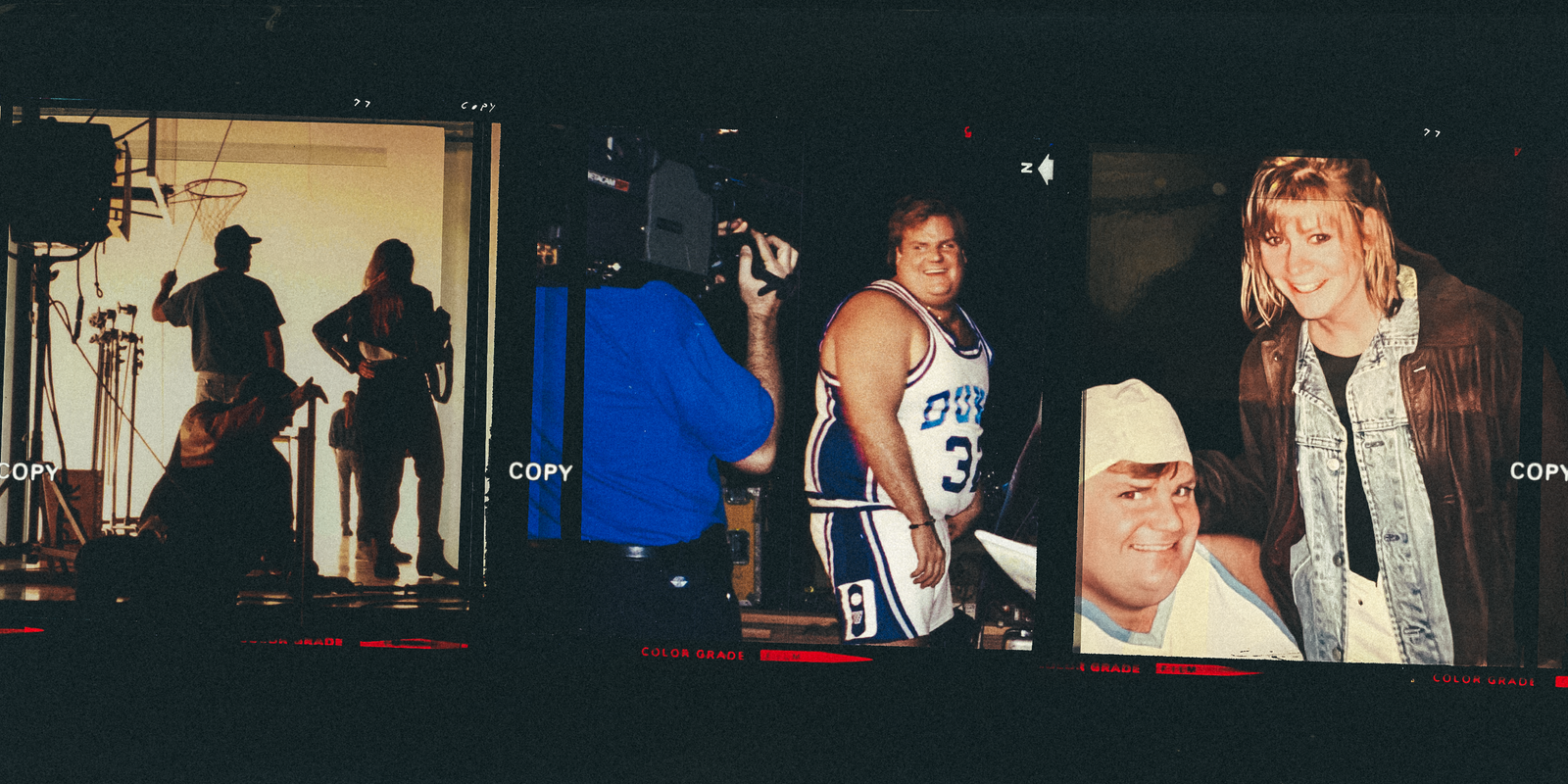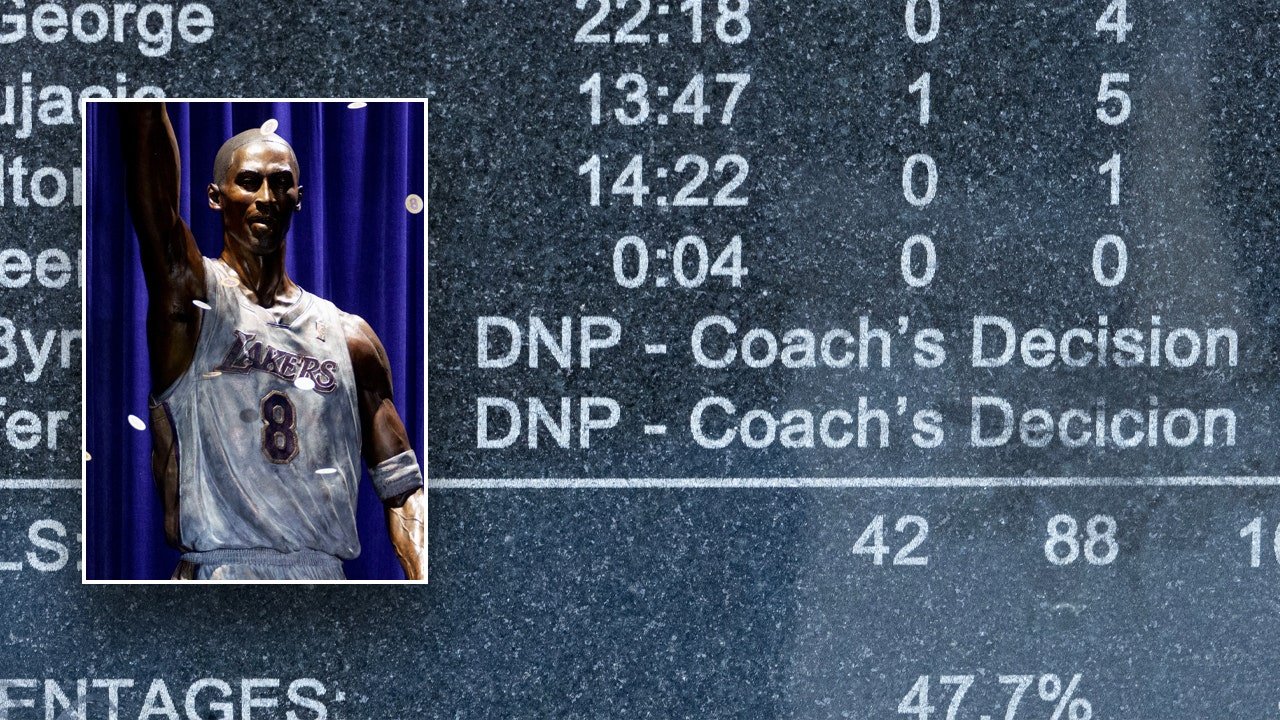
Thirty years ago, Chris Farley and college basketball collided in an unforgettable way
[ad_1]
Thirty years later, Christian Laettner isn’t sure he knew it was coming. In 1994, he was in the NBA, his second season with the Minnesota Timberwolves. Maybe someone had informed his agent but he doesn’t think so.
The former Duke star just one day remembers seeing the commercial on ESPN. Chris Farley, then at the height of his “Saturday Night Live” glory, dressed in Laettner’s No. 32 jersey, recreating his buzzer-beating shot against Kentucky, a signature moment in NCAA Tournament history.
“All I know is that all of a sudden it was out and it was hilarious and it was awesome,” Laettner told The Athletic.
Farley did three spots that aired on ESPN, all promoting college basketball, all remembered for the physical comedy and shenanigans that made Farley so beloved and famous.
In one spot, Farley was Michigan’s Rumeal Robinson, standing at the foul line, needing to sink two free throws to win the 1989 national championship. “And he makes it look … ” Farley says, before firing and missing, not once, not twice but six times, yelling out in famed Farley frustration (“GET IN THERE!”) after each brick.
In another, he’s North Carolina’s Michael Jordan in the 1982 title game, but instead of sinking the winning jumper from the wing, Farley decides to take a step-back 3 (he was ahead of his time on this), correctly pointing out in the end that college basketball did not have a 3-point line at the time.
But it’s the Laettner ad that’s so fantastic, so funny, so Farley.
“OK, I’m Christian Laettner,” the comedian begins, wearing a tight Duke uniform. “1992. Duke-Kentucky. Kentucky’s up by one, Christian’s got the ball. Two seconds left.”
Farley turns and faces five Kentucky defenders, life-sized cutouts made from plywood. He dribbles and shoots a turnaround jumper, just as Laettner did that memorable afternoon in Philadelphia in the East Regional final.
Nope.
“Off the glass!”
“Gets his own rebound!”
Miss.
“Loose ball!”
Farley dives and knocks over a Kentucky cutout. Finally, he banks in a layup and raises his arms in celebration.
“Duke wins! Game of the century,” Farley yells. “And that’s the way it happened! … Well, almost.”
Actually, this is how it happened.
In 1993, Glenn Cole worked at Wieden+Kennedy, an ambitious advertising firm based in Portland, Ore. Although it’s a global agency today, Wieden+Kennedy back then devoted a bulk of its resources to one client, Nike. It was known for “Bo Knows” and for Mars Blackmon telling Jordan, “Money, it’s gotta be the shoes.”
A copy writer, Cole, 24, was the youngest at the firm. A former sprinter at the University of Oregon, he loved the creativity and story-telling advertising provided, especially at Wieden+Kennedy. He described himself in that environment as an “idiot who was an intern half a minute ago.” But his superiors thought enough of him to assign him an ESPN campaign that came with a simple task.
Promote college basketball.
“Got the keys to this kind of cool car. Nobody’s looking at it,” said Cole, referring to all the attention the firm gave to Nike. “I have an ESPN basketball campaign. I watch a lot of ‘Saturday Night Live.’ And I was obsessed with Chris Farley.”
Cole had an idea. A common basketball moment — playing solo on a playground. Tie game. Clock winds down. 3 … 2 … 1.
Yet the shot seldom drops. The countdown resets. No game-winning heroics, only an asphalt do-over.
“And so I thought that’d be funny to kind of screw with that trope,” Cole said. “And then I was like, ‘Oh my God, Chris would be the perfect person to do that.’”
Approaching 30, Farley was a rising star. The New York Daily News had called him the breakout performer of SNL’s latest season, one who had brought the same sort of “volcanic, magnetic energy” as Eddie Murphy and John Belushi before him. His talent and comedy had started to transfer to the big screen. “Tommy Boy,” which starred Farley and David Spade, would open in 1995.
Even better in this case: Farley was a sports fan. Growing up in Madison, Wis., he had played hockey and football. At Marquette, he had played club rugby. At SNL, he played pickup hoops with cast mates at 76th Street Basketball Court at Riverside Park.
“Chris was a gifted physical comedian,” said Doug Robinson, Farley’s agent. “And a lot of people don’t know that Chris really was a tremendous athlete. He moved really well. He loved sports. So if Chris was going to do physical comedy, he was going to commit to whatever it is that he did.”
Cole flew to Los Angeles to pitch the concept to Farley. ESPN asked if he had a back-up plan in case Farley declined. “Of course,” Cole said.
Actually, he did not.
“I remember thinking, ‘This is a long shot,’” said Beth Barrett, a producer on the campaign. “It was back in the time when it wasn’t as common as it is now for celebrities and celebrity athletes and comedians and musicians to sell out to commercials. It was almost like a bad thing to be in a commercial.”
Cole met Farley in Farley’s hotel suite. Farley wore a tweed suit, disheveled by design. Cole pitched his vision, and Farley grasped it immediately. The comedian got off the couch and started acting out the Laettner spot. He knocked over a vase, which made Cole instantly realize: “Oh, I have to get something for you to knock over.”
“Yeah, this sounds like a lot of fun,” Cole remembers Farley saying. “Let’s do it.”
The spots were shot days later at a Los Angeles studio. Today, a celebrity likely would show up with an entourage of sorts. But back then, Larry Frey, the creative director on the campaign, recalls Farley’s manager arriving early and Farley pulling up later by himself. Spade dropped in around lunchtime.
“He was literally like a 10-year-old kid, and they just called recess,” Frey said. “Full of energy. Like, ‘Hey, guys! I’m probably going to screw it up today.‘ Super self-deprecating. Super enthusiastic. And just winging it.”
They shot the Michigan and North Carolina spots first, mostly because Cole knew what Farley had planned for Laettner and did not want to risk his star getting hurt.
(In addition to the ads, Farley also shot a series of promos that never aired. In the one below, Farley holds two stuffed animals and pantomimes a conversation about an upcoming rivalry game. Of course, the mascots soon attack each other, and then Farley, and the promo ends with a trademark Farley outburst.)
For the Laettner spot, Cole provided simple instructions.
“Look, I’m going to put you at the 3-point line,” he recalled telling Farley. “We’re going to start this play the way everybody remembers it in our collective memory. And then look, man, try and make the shot, but if you don’t, just hurry up and try to finish the play and surprise me.”
Farley, unleashed.
Farley at his best.
He barreled through cutouts of former Kentucky standouts Deron Feldhaus, John Pelphrey and Travis Ford, knocking them to the floor.
“A whirlwind,” Barrett said.
Good ideas don’t always translate. Cole knew instantly this one did.
“In every single one of them, right after the first take of every spot — all three — I was like, ‘Ah, f—, this is going to be incredible,’” he said.
In “The Chris Farley Show: A Biography in Three Acts,” authors Tom Farley Jr. and Tanner Colby describe this period as the highpoint of Farley’s life.
The comedian had battled drug and alcohol addiction, but after a trip to an Alabama rehab facility, he was trying to stay clean. Farley was confident and self-assured, the authors wrote, but it ultimately was a losing battle. In 1997, Farley died of an overdose at age 33.
When Cole and Barrett look back on that day in Los Angeles, the experience stands out as much as the finished product. Farley had performed as usual on camera. (After every take, he’d ask: “Was that funny?”) But he was also personable and engaging the entire eight hours he was there.
“We’d go hang out in the green room between set-ups and he asked questions and was interested in other people,” Barrett said. “And just (be) kind of a goof. It was just one of those experiences that was pretty rare in advertising where you actually really got to know somebody by the end of the day. It was pretty great.”
Farley and Cole had connected so well, riffing back and forth, exchanging ideas, Farley had asked him if he had interest in writing for him at SNL. Cole panicked, thinking, “What if I can’t jam out great stuff every week?” It was an incredible offer, but Cole loved what he was doing. He declined.
“That was my third project in advertising as I recall, but it was the first one where I felt like I was collaborating with somebody to make something better than I or he could make independently,” said Cole, who today is co-founder and chairman at 72andSunny, a global ad agency.
A year or two after the commercials aired, Laettner walked on a jetway, about to board a plane. He does not remember which airport or where he was headed, but as soon as he boarded he spotted a familiar face sitting in first class. It was Farley.
Like most celebrities, Farley was looking down, trying not to get noticed, but he made eye contact with Laettner. Farley stood, and the basketball star and comedian embraced and shared a laugh.
“Awesome commercial,” Laettner told him.
Chris Farley and Glenn Cole, backstage at the college basketball commercial shoot. (Courtesy of Glenn Cole)
(Top illustration: Daniel Goldfarb / The Athletic; photos and videos courtesy of Glenn Cole)
[ad_2]
Source link


